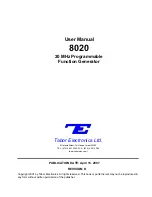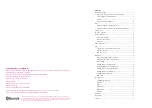
37
CHAPTER 5: Command Descriptions
Bus Addressing
pri-addr
A two-digit primary device address in the range of 00 to 30.
sec-addr
An optional two-digit secondary device address in the range of 00 to 31.
addr
An IEEE bus address. A numeric primary address optionally followed by a secondary
address. Thus
addr
is of the form...
{pri-addr [sec-addr]}
where
pri-addr
is a two-digit primary address in the range from 00 through 30 and
sec-addr
is a two-digit secondary address from 00 through 31. Numeric addresses
must be given as two-digit numbers: for example, 05 for address 5, and 1601 for
primary address 16, secondary address 1.
[,addr]
An optional bus addresses list, each address preceded by an address separator: either
a comma (,), a slash (/) or a period (.).
No more than 15 bus addresses are allowed in any single command.
Character Count
#count
The number of characters to be transferred. A pound sign (#) followed by an integer
in the range of 1 to 65535 (2
16
-1). May be specified in hexadecimal by preceding it
with &H. The hexadecimal range is &H1 to &HFFFF. A zero character count is
invalid.
ASCII Characters
$char
A single character whose ASCII value is the number
char
, a decimal number in the
range from 0 to 255, or a hexadecimal number in the range from &H0 to &HFF. For
example, $65 is the letter “A,” as is $&H41.
CR
The carriage return character ($13, $&H0D).
LF
The line feed character ($10, $&H0A).
'X
Any printable character. The apostrophe is immediately followed, without any
intervening spaces, by a single character which is taken to be the character specified.
ASCII Character Strings
data
An arbitrary characters string. No special forms given above (
$char
,
CR
,
LF
, or
'X
)
are used. For example,
CRLF
as data is taken as the letters “C,” “R,” “L,” and “F,” not
as carriage return and line feed.
'data'
An arbitrary characters string enclosed in apostrophes (') or quotes (").
















































